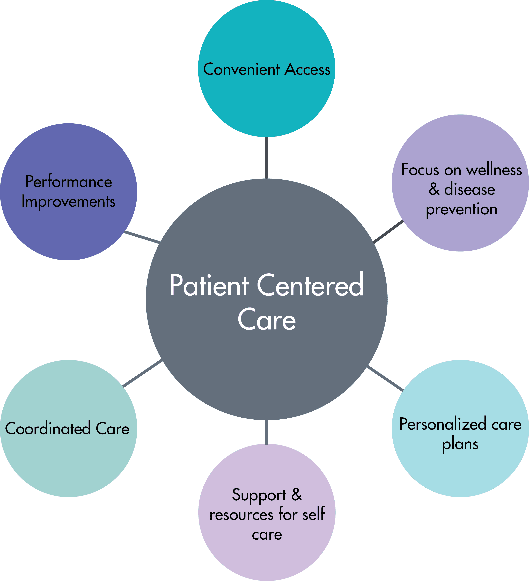In the ever-changing environment of healthcare, embracing patient-centered care paradigm is the key to providing great service. As doctors, you are at the vanguard of this shift, tasked not just with diagnosing and treating medical conditions, but also with ensuring that your patients receive compassionate, empathic, and personalized care. Let’s look at the concept of patient-centered care and how to design a model that puts patients at the center of healthcare delivery. By taking this approach, you may improve the quality of treatment you deliver, increase patient satisfaction, and ultimately help shape the future of medicine.
The Patient-Centered Care Revolution- what is it?

Historically, healthcare has been seen from a provider-centric standpoint, with the doctor’s knowledge and skills taking center stage. However, the paradigm is transforming, and the patient is now center stage. Several causes are driving this shift:
“The Informed Patient”: Patients have access to large volumes of medical information in today’s digital age. They are more aware and engaged in their healthcare decisions, necessitating collaboration and transparency on the part of healthcare professionals.
“Improved Outcomes”: Studies have demonstrated that patient-centered treatment results in better clinical outcomes, cheaper healthcare costs, and fewer hospitalizations. It is not only about making patients happy; it is also about getting better results.
“Regulatory Emphasis”: In their norms and guidelines, regulatory bodies and healthcare accrediting organizations are progressively emphasizing the need for patient-centered care.
“Competition”: As the healthcare business becomes more competitive, patients have more options. To differentiate themselves, healthcare providers must prioritize great service delivery.

“Crafting a Patient-Centered Care Model”
Creating Trust and Rapport
The core of patient-centered treatment is trust and rapport. Patients must feel at ease, protected, and confident in their relationship with their healthcare professional. Building trust can be accomplished through effective communication, attentive listening, and empathy. Take the time to get to know your patients and comprehend their fears, anxieties, and expectations. Answer their inquiries and involve them in decision-making to make them feel respected and heard.
Effective Communication
Clear and effective communication is at the heart of patient-centered care. Avoid medical jargon and seek to explain medical concepts in a way that your patients will comprehend. Encourage questions and deliver direct, honest responses.
Outline the benefits and drawbacks of each therapy option and include the patient in the decision-making process. This collaborative approach gives patients the ability to make educated decisions regarding their care.

Individualized Treatment Strategies
Every patient is unique, and their healthcare need should reflect that. Customize your treatment strategies to each patient’s unique situation and preferences. Consider their medical history, lifestyle, and cultural background. This personalized approach not only improves patient satisfaction but also boosts therapy adherence and success.
Compassion and Emotional Support
Empathy is the ability to understand and share another person’s feelings. This entails doctors acknowledging the emotional components of illness and therapy. Patients frequently suffer dread, anxiety, and uncertainty, and your responsibility as a doctor is to help them overcome these feelings.
Patients frequently suffer dread, worry, and uncertainty, and your role as a doctor extends beyond diagnosis and therapy. Emotional support, empathy, and compassion can all have a significant impact on your patients’ overall well-being.
Access to timely care
Patients place a premium on fast access to healthcare services. It is critical to reduce wait times and make rapid appointments, particularly for urgent medical situations. In addition, make certain that your office personnel is properly trained to handle scheduling, and resolving any problems or delays with professionalism and kindness.
Patient Information
Educating your patients about their treatment options, and preventive measures gives them the ability to take an active role in their health. To enhance your explanations, provide textual materials, employ visual aids, and reference trustworthy web resources. Patients are more likely to follow suggested regimens if they comprehend their problems and the reasoning for their treatment.
“Continuity of Care”
Patient-centered care requires continuity of care. Whenever feasible, ensure that patients have a consistent healthcare provider. This results in improved rapport, a better understanding of the patient’s history, and more effective continued care. When you are unable to offer care due to schedule conflicts or other circumstances, support open communication and patient information sharing among your colleagues.
Quality Improvement and Feedback
Encourage patient feedback to continuously improve your patient-centered care strategy. Create a mechanism for gathering and analyzing both good and negative comments. Use this data to discover areas for improvement and make adjustments to improve patient experiences.
Possible challenges
While the concept of patient-centered care is admirable, it is not without its difficulties. Here are some frequent issues that healthcare providers confront, as well as potential solutions:
Time Restriction: Doctors sometimes operate on tight schedules, making it difficult to spend adequate time with each patient. Longer appointment windows for initial consultations and complex cases, allowing for more in-depth conversations, is one approach.
EHRs (Electronic Health Records): EHRs are a useful tool, but they can sometimes interfere with patient-doctor contact. Maintain eye contact with your patient and take the opportunity to discuss crucial details away from the patient.

Resistance: Adopting a patient-centered care strategy may face opposition from colleagues or personnel. It is critical to set a good example by exhibiting the benefits of this strategy in your contact with patients and the positive results it can achieve.
Constraints: Limited resources and economic constraints can stymie efforts to provide great service. Creativity, on the other hand, can go a long way. Look for new approaches to improve patient experiences that don’t require large financial commitments, such as telemedicine or remote monitoring.
The Advantages of a Patient-Centered Care Model

Patient Satisfaction: Higher levels of patient satisfaction result from patient-centered care, which can lead to improved loyalty, referrals, and favorable online reviews.
Improved outcomes: Patients who participate in their healthcare decisions and treatment plans are more likely to follow recommendations, resulting in better health results.
Healthcare Cost Savings: Preventing hospital readmissions and needless medical procedures can help healthcare providers and patients save money.
Greater Reputation: Adopting a patient-centered care paradigm can distinguish you from the competition and position you as a leader in your sector.
Making patients happy isn’t the only goal of developing a patient-centered care model; it’s also about enhancing the quality of healthcare delivery, attaining better clinical outcomes, and determining the future of medicine. By putting patients at the centre of your practice, you have the power to drive this transition. You may create a genuinely excellent healthcare experience by developing trust, communicating effectively, giving personalized care, and providing emotional support. The obstacles are serious, but the advantages are substantial, with far-reaching implications for your patients and the healthcare industry as a whole.









